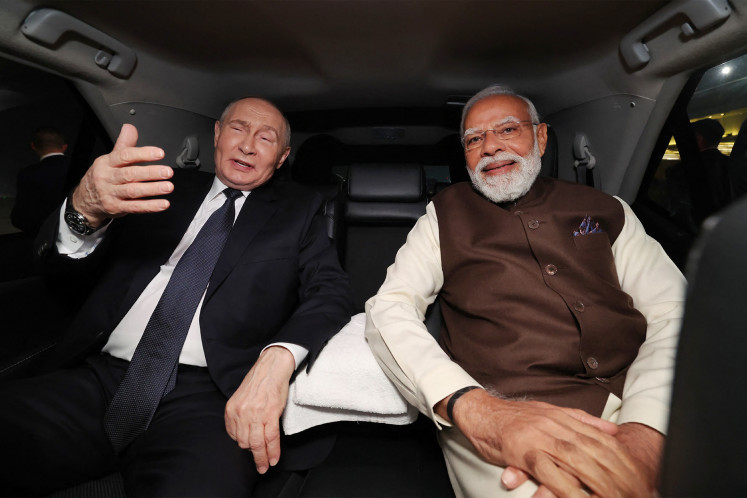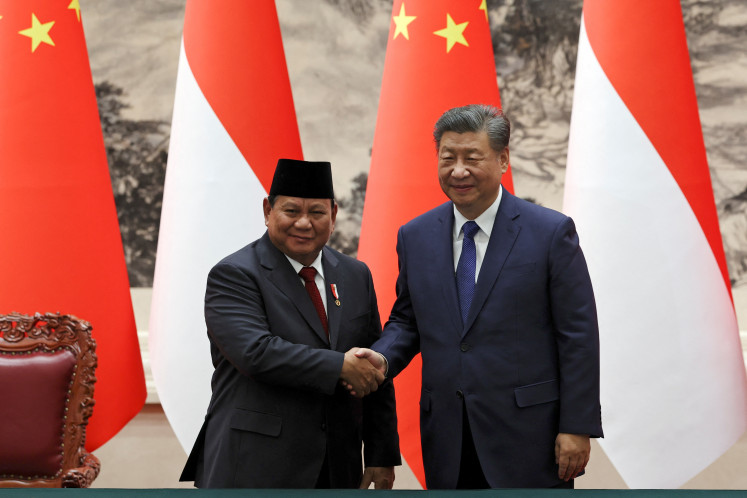Popular Reads
Top Results
Can't find what you're looking for?
View all search resultsPopular Reads
Top Results
Can't find what you're looking for?
View all search resultsThe false dichotomy of Hiroshima and Nagasaki
Americans must admit that the nuclear war against Japan was one of the greatest atrocities in human history. For the first time ever, we humans now have the power to bring about our own extinction. There is absolutely nothing “necessary” about this evil.
Change text size
Gift Premium Articles
to Anyone
S
eventy-five years ago, the United States waged the only nuclear war in history. Among the truths held self-evident by millions of Americans is the notion that the atomic destruction of Hiroshima and Nagasaki saved lives, both American and Japanese.
The choice, Americans are told starting as school children and throughout their lives by largely uncritical media, was between nuclear war and an even bloodier protracted invasion of Japan, whose fanatical people would have fought to the death defending their homeland and their divine emperor.
As with so many other dark chapters in US history, the official narrative of the decision to unleash the most destructive weapon humanity has ever known upon an utterly defeated people is deeply flawed.
The Japanese had in fact been trying to find a way to surrender with honor for months before the atomic bombs were dropped, and US leaders knew it.
After years of war and privation, Japan’s people had had enough, and so had many of its leaders. The Allies, through a secret cryptanalysis project codenamed Magic, had intercepted and decoded secret transmissions from Shigenori Togo, the Japanese foreign minister, to Naotaki Sato, the ambassador in Moscow, stating a desire to end the war.
“His Majesty is extremely anxious to terminate the war as soon as possible,” Sato cabled on July 12. However, saving face was imperative to the Japanese, which meant retaining their sacred emperor. Unconditional surrender was, for the time being, out of the question.
In a secret memo dated June 28, Undersecretary of the Navy Ralph A. Bard wrote that “the Japanese government may be searching for some opportunity which they could use as a medium of surrender.” In a 1960 interview, Bard reiterated that “the Japanese were ready for peace and had already approached the Russians” about capitulating.
On July 26, 1945, the leaders of the US, Britain and China issued the Potsdam Declaration, demanding unconditional Japanese surrender and vowing “prompt and utter destruction” — the US had successfully tested the first atomic bomb in New Mexico 10 days earlier — if Japan refused. The declaration was originally written so that Emperor Hirohito would not be removed from the Chrysanthemum Throne, with Japan to be ruled as a constitutional monarchy after the war.
However, Secretary of State James Byrnes removed that language from the final declaration. It would be unconditional surrender or total annihilation.
President Harry S. Truman, who only learned about the Manhattan Project after being sworn in following Franklin D. Roosevelt’s death on April 12, approved a plan to drop two atomic bombs on Japan. Planners sought undamaged cities where military facilities were located near civilians, and the decision was made to detonate the bombs hundreds of meters in the air for maximum destructive effect.
Tokyo, which in early March suffered firebombing that killed more people than either of the atomic bombs, was off the table as a target. Kyoto was spared due to its cultural significance. Kyoto’s good fortune would mean the Nagasaki’s destruction. Hiroshima, Japan’s largest untouched target, would die first.
Seven of the eight five-star US generals and admirals in 1945 opposed using the atomic bomb against Japan. One of them, Gen. Dwight D. Eisenhower, later said that “the Japanese were ready to surrender and it wasn’t necessary to hit them with that awful thing.”
Despite so much high-level misgiving, the US did “hit them with that awful thing.” The idea of giving Japanese officials a live demonstration of an atomic bomb on a remote island, proposed by Strategic Bombing Survey vice chairman Paul Nitze and supported by Navy Secretary James Forrestal, was rejected. The US was already destroying multiple Japanese cities every week; it was believed that such a demonstration would likely not have moved the Japanese any more than the ongoing destruction of their actual cities.
“The Japanese could not fight a two-front war, and were more anti-communist than the Americans were,” Martin Sherwin, an historian awarded the Pulitzer Prize for co-authoring a biography of Manhattan Project leader Dr. J. Robert Oppenheimer, said a recent webinar sponsored by over two dozen international peace organizations. “The idea of a Soviet occupation of Japan was their worst nightmare.”
Historian and professor Peter Kuznick, who with Oliver Stone co-authored the bestselling The Untold History of the United States, also spoke at the webinar, adding that “the Joint Chiefs of Staff repeatedly reported that if the USSR should enter the war then Japan would realize that defeat is inevitable.” Kuznick also noted that General George Marshall, the only five-star US officer to approve of using the atomic bomb, said that a Soviet invasion would likely lead to Japan’s swift surrender.
Not only were Hiroshima and Nagasaki the last battles of World War II, they were also the first battles of the Cold War. American leaders knew very well that the Soviet Union would feature prominently in the postwar world order. The US wanted to maximize its own position as the dominant world power, and what better way to do this than to show the Russians that the US had the cold resolve necessary to unilaterally wage nuclear war, even when it enjoyed an atomic monopoly and dropping the bomb wasn't even necessary?
According to Manhattan Project scientist Leo Szilard, Secretary Byrnes believed that “Russia might be more manageable if impressed by American military might, and that a demonstration of the bomb might impress Russia.”
But instead of “managing” Russia, some US officials admitted that waging nuclear war actually empowered it, encouraging Moscow to rush to develop its own nuclear arsenal, which it did in 1949.
The official US narrative blames the Soviet Union for starting the Cold War and the nuclear arms race, which on numerous occasions over the following decades brought the world within reach, and once to the brink, of thermonuclear annihilation. But it was the US that fired the first fiery salvo, forcing the Soviets to scramble to develop their own deterrent and launching an arms race in which there are now thousands of nuclear warheads in the arsenals of a record number of countries, with the risk of nuclear Armageddon as real as it has ever been.
Americans must admit that the nuclear war against Japan was one of the greatest atrocities in human history. For the first time ever, we humans now have the power to bring about our own extinction. There is absolutely nothing “necessary” about this evil.
***
The writer is a journalist, regular contributor to Common Dreams and Counterpunch and member of Collective 20, a new anti-war collective with Noam Chomsky, Medea Benjamin and others.










